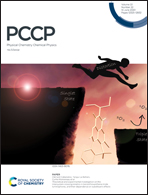Proton affinities of pertechnetate (TcO4−) and perrhenate (ReO4−)†
Abstract
The anions pertechnetate, TcO4−, and perrhenate, ReO4−, exhibit very similar chemical and physical properties. Revealing and understanding disparities between them enhances fundamental understanding of both. Electrospray ionization generated the gas-phase proton bound dimer (TcO4−)(H+)(ReO4−). Collision induced dissociation of the dimer yielded predominantly HTcO4 and ReO4−, which according to Cooks’ kinetic method indicates that the proton affinity (PA) of TcO4− is greater than that of ReO4−. Density functional theory computations agree with the experimental observation, providing PA[TcO4−] = 300.1 kcal mol−1 and PA[ReO4−] = 297.2 kcal mol−1. Attempts to rationalize these relative PAs based on elementary molecular parameters such as atomic charges indicate that the entirety of bond formation and concomitant bond disruption needs to be considered to understand the energies associated with such protonation processes. Although in both the gas and solution phases, TcO4− is a stronger base than ReO4−, it is noted that the significance of even such qualitative accordance is tempered by the very different natures of the underlying phenomena.

- This article is part of the themed collection: 2020 PCCP HOT Articles


 Please wait while we load your content...
Please wait while we load your content...
